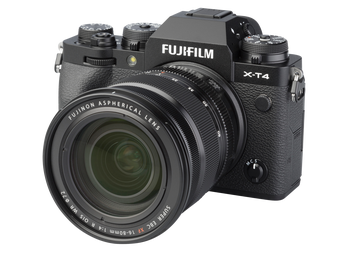- Exceptional image quality
- 8K video recording
- Fast and accurate autofocus
- Compact and lightweight
- Excellent image quality
- Stabilized video
- User-friendly controls
- High-speed shooting
- High price
- Large file sizes
- Limited battery life
- APS-C sensor may not suit all
Canon EOS R5 vs Fujifilm X-T4
The world of mirrorless cameras has evolved significantly over the years, offering photographers a range of options that surpass traditional DSLR cameras. Two notable models that have garnered attention are the Canon EOS R5 and the Fujifilm X-T4. In this comparison, we'll delve into the features, performance, and suitability of each camera to help you decide which one best fits your needs.
Sensor and Image Quality
The Canon EOS R5 boasts a 45-megapixel full-frame CMOS sensor, which provides exceptional image quality with impressive detail and dynamic range. This sensor is also capable of capturing 8K video, making it an attractive option for videographers. On the other hand, the Fujifilm X-T4 features a 26.1-megapixel APS-C X-Trans CMOS 4 sensor, which, although smaller than the Canon's full-frame sensor, still delivers outstanding image quality with excellent color accuracy and low noise.
While the Canon EOS R5 has a higher megapixel count, the Fujifilm X-T4's sensor is optimized for its APS-C format, resulting in a more efficient use of pixels. This translates to better low-light performance and faster autofocus. However, if you're looking for ultimate image quality and resolution, the Canon EOS R5 might have a slight edge.
Autofocus and Performance
The Canon EOS R5 features a advanced Dual-Pixel AF system with 5,940 selectable AF points, covering almost the entire sensor area. This results in incredibly fast and accurate autofocus performance, even in challenging lighting conditions. The Fujifilm X-T4, on the other hand, employs a hybrid autofocus system with phase-detection pixels integrated into the sensor, offering 425 AF points.
While both cameras have impressive autofocus capabilities, the Canon EOS R5's system is more comprehensive and flexible, making it better suited for fast-paced and dynamic subjects like sports or wildlife photography. The Fujifilm X-T4's autofocus is still excellent, but might not quite match the Canon's speed and accuracy in certain situations.
Video Capabilities
Both cameras are capable of producing high-quality video, but they differ in their approach. The Canon EOS R5 can capture 8K video at 30p, as well as 4K video at up to 120p. The Fujifilm X-T4, on the other hand, can record 4K video at up to 60p and 1080p video at up to 240p.
The Canon EOS R5's 8K capability makes it an attractive option for videographers who need the highest possible resolution. However, the Fujifilm X-T4's more modest video capabilities are still well-suited for most applications, including documentary, event, and social media content creation.
Ergonomics and Build Quality
The Canon EOS R5 has a solid, weather-sealed body that feels similar to traditional DSLR cameras. It features a comfortable grip, intuitive controls, and a high-resolution vari-angle touchscreen LCD. The Fujifilm X-T4 also boasts a sturdy, weather-resistant design with a familiar control layout, but its body is slightly smaller and more compact.
While both cameras are well-built and ergonomic, the Canon EOS R5's larger size and more pronounced grip make it feel more substantial in the hand. However, the Fujifilm X-T4's more compact design makes it easier to carry around, especially for travel or street photography.
Conclusion
In conclusion, both the Canon EOS R5 and the Fujifilm X-T4 are exceptional cameras that offer unique strengths and weaknesses. If you're looking for ultimate image quality, advanced autofocus, and 8K video capabilities, the Canon EOS R5 might be the better choice. However, if you prefer a more compact and agile camera with excellent image quality, fast autofocus, and robust video features, the Fujifilm X-T4 is an excellent option.
While traditional DSLR cameras are still popular among some photographers, mirrorless models like the Canon EOS R5 and the Fujifilm X-T4 have largely surpassed them in terms of performance, versatility, and innovation. Ultimately, the choice between these two cameras will depend on your specific needs, preferences, and shooting style.

































